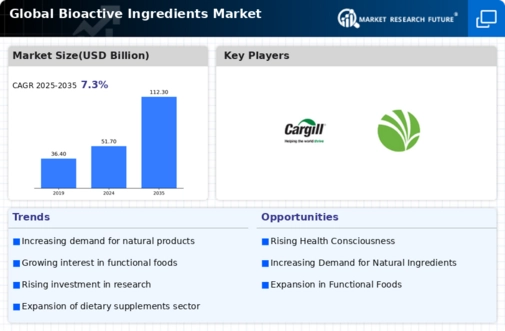Market Analysis
In-depth Analysis of Bioactive Ingredients Market Industry Landscape
The market dynamics of bioactive ingredients reflect a complex interplay of factors that collectively shape its landscape. Bioactive ingredients, often derived from natural sources, have garnered significant attention across various industries due to their potential health benefits and versatile applications. One key driver of the market is the increasing consumer awareness and demand for healthier and functional products. As individuals become more conscious of their well-being, there is a growing preference for products enriched with bioactive ingredients, which are believed to have positive effects on health and contribute to disease prevention.
The food and beverage industry plays a pivotal role in influencing the dynamics of the bioactive ingredients market. With consumers seeking nutritious and functional food options, manufacturers are incorporating bioactive ingredients into a diverse range of products, including beverages, snacks, and supplements. This trend is further fueled by the desire for natural and clean-label products, as bioactive ingredients are perceived as wholesome and free from synthetic additives. As a result, the market experiences a surge in demand from both the food industry and health-conscious consumers.
The pharmaceutical and nutraceutical sectors also significantly contribute to the market dynamics of bioactive ingredients. The potential health benefits associated with these ingredients, such as antioxidant properties, anti-inflammatory effects, and immune system support, make them attractive for inclusion in pharmaceutical formulations and dietary supplements. The ongoing research and development efforts in these sectors further drive innovation and expansion within the bioactive ingredients market.
The cosmetics and personal care industry adds another dimension to the market dynamics, with bioactive ingredients finding applications in skincare, haircare, and other beauty products. Consumers increasingly seek products that not only enhance their appearance but also offer additional benefits to skin health and well-being. As a result, cosmetic companies are incorporating bioactive ingredients known for their skin-rejuvenating and anti-aging properties, influencing the market dynamics and creating new opportunities for growth.
The agricultural sector contributes to the market dynamics through the cultivation of crops rich in bioactive compounds. Plant extracts, herbs, and botanicals serve as sources for bioactive ingredients, and the demand for these natural compounds has led to increased cultivation and sustainable sourcing practices. Agricultural practices, therefore, play a role in shaping the availability and pricing of bioactive ingredients in the market.
Technological advancements and innovations in extraction and processing techniques also impact the dynamics of the bioactive ingredients market. Efficient methods for extracting and preserving the bioactive compounds from natural sources contribute to the overall market growth. Additionally, advancements in formulation technologies enable the development of bioactive ingredient-rich products with enhanced stability and bioavailability, expanding the application possibilities across various industries.
Market dynamics are not without challenges. Regulatory considerations and standards for health claims associated with bioactive ingredients influence market dynamics, requiring companies to navigate compliance hurdles. Furthermore, the market is characterized by intense competition, with both established players and new entrants vying for market share. Differentiation through innovation, quality, and sustainability practices becomes crucial for companies aiming to thrive in the competitive landscape.





Leave a Comment